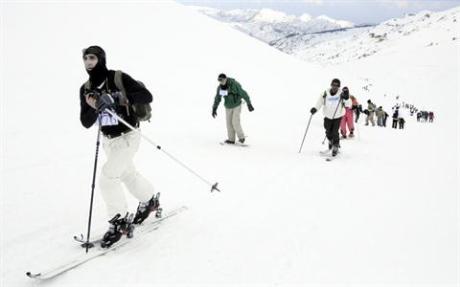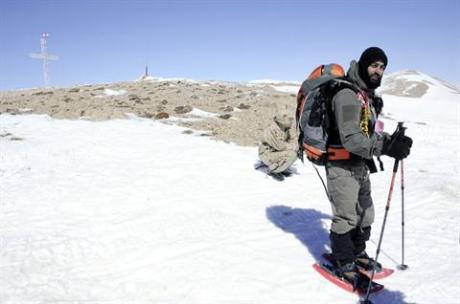TANNOURINE, Lebanon: Keep your head down. Don’t bother to look up. Use the ski poles. Small paces. Count the steps and rest at 100. One ... two ... three ... Keep going!
Struggling half way up the ever-steeper slopes of Wadi Bayda east of the Tannourine cedars reserve, blinded with sweat, chilled by the icy wind and gasping for breath in the thin mountain air, welcome to the Raid Des Cedres, the annual ski and snowshoe race organized by the Lebanese Army’s Rangers Brigade.

The event, now in its fourth year, has become the premier mountaineering race in Lebanon, linking the Tannourine and Bsharre cedar reserves. It is based on the Swiss army’s “Patrouille des Glaciers” ski running race in the Alps and draws a diverse mix of military personnel and civilians from Lebanon and overseas. Participants form teams of three and have to pass through several checkpoints en route, meaning that each team is as fast as the slowest member.
The three categories of the Raid des Cedres include a 45-kilometer race for skiers, a 30-kilometer race for skiers and one of 18 kilometers for snowshoers.

In the past three years, the race started before dawn at the entrance of the Tannourine cedars reserve with most competitors sleeping in canvas tents provided by the army. But the unusually heavy snowfall this winter and the difficulty in reaching the reserve by car meant that all competitors this year stayed the night in the nearby village of Hadath al-Jebbe in a couple of empty buildings requisitioned by the army.
General Charbel Roukhoz, the commander of the Ranger’s Brigade held a briefing Saturday evening for participants in a large canvas marquee erected in a snowy field outside the village. It was then that he confirmed what had previously been rumored. The race this year would start from Hadath al-Jebbe which meant we would have to ski or snowshoe an additional 5.5 kilometers uphill before reaching the traditional starting point at the Tannourine cedars reserve.
After the briefing, soldiers and civilians quickly devoured trays of food while bonfires were lit outside the tent providing beacons of glowing warmth in the freezing night air. At an altitude of over 1,500 meters, the night sky was awash with stars, highlighted by the rare sight of a razor-thin crescent of moon flanked by the silver orbs of Venus and Jupiter.
There was little sleep to be had. By 4:30 a.m., with dawn still an hour away, most competitors had begun to assemble beside the starting line, swigging plastic cups of sweet coffee provided by the army, cinching straps and adjusting ski fittings.
The competitors numbered around 300 and were a mix of whip-lean athletes intent on winning their sections and the rest of us who were simply hoping to finish the course.
At 5 a.m., a red flare was fired into the sky and the race was on. The initial cheers and shouts of encouragement soon faded as the pack began to thin out and the only sound was the slither of skis and the crunch of snow shoes on the frozen snow. Head torches lit the way, but after half an hour, the faintest traces of lightening sky were discernible above the mountains far to the east informing us that dawn was imminent.
In past years, the race began with a long climb up Wadi Bayda that takes us to the mountain crest on the southern side of the Bsharre cedars. It is a hard climb even when fresh at the onset of the race. This year, however, we began ascending the valley after having already negotiated six kilometers of snow and icy road. The dawn sun initially failed to penetrate the mantle of cloud above us, turning the dramatic landscape of Wadi Bayda into a monochromatic vista of whites, blacks and grays. But when the sun did break through the cloud, it was if the door of a giant oven had suddenly been flung open. Perspiration soaked through clothing which became evident with each gust of icy wind.
Exhausted competitors paused for breath on the slope, leaning against ski poles, heads sagging, drawing in lungfuls of thin air.
There was little respite on reaching the head of the valley. Although the terrain was a little easier to negotiate, the snow shoe competitors still had another 500 meters in altitude to tackle before reaching the highest point of the route at Al-Oudaa at 2,700 meters.
Occasionally, when the cloud lifted, we were afforded sweeping views of the landscape to the south, a vast undulating blanket of snow reaching as far as the Sannine mountains, 30 km away.
The physical effort began to take its toll. During the morning, a snow clearing vehicle trundled up and down the route picking up those that could go no further. One man on snowshoes asked, “Do you know how much further it is to the cross?” a reference to the giant steel cross marking the summit of Al-Oudaa.
On being informed that it was still another four kilometers away, his face crumpled into an expression of despair and defeat.
Although the Raid Des Cedres is supposed to be a demonstration of team work, most of the three-man teams broke up early on as each competitor found his or her own pace.
At the finish line beside the Bsharre cedars, soldiers asked solo competitors what had happened to their teammates.
“God knows. They gave up, they’re still in the mountain, I don’t care,” said one exhausted racer.
Yousseph Salameh, a founder of the Stamina Mountaineering Club, said that Raid Des Cedres was an exceptional event in Lebanon. “It’s the best competition going till now. It’s a great way to meet new people and to gain further experience,” he added.
On March 4, the Rangers Brigade hosts the second part of this year’s Raid Des Cadres with a ski and snow shoe race on Mount Hermon.
February 28, 2012 01:44 AM
By Nicholas Blanford
The Daily Star
(The Daily Star :: Lebanon News :: http://www.dailystar.com.lb)

| 

